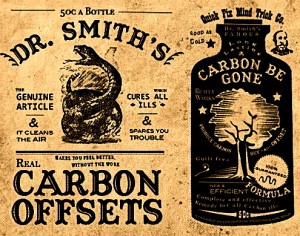Dickinson to Durban » Carbon Markets, Climate Change, Key COP17 Issues, Mosaic Action » Stop! Don’t Offset… Carbon Offsets the Snake Oil of CO2 Mitigation
Stop! Don’t Offset… Carbon Offsets the Snake Oil of CO2 Mitigation

Mr. Smith's Miracle Carbon Offsets! They rid you off your CO2 emissions and the heavy money in your pocket!
by Sam Parker, ’12
In 2009, there was a bill, called the Waxman-Markey Climate Bill, that has passed through the House and was killed in the Senate. This bill was potentially one of the most significant climate laws to have ever been seen in the U.S. It would instate a Cap and Trade system of carbon trading on U.S. coal power plants . This bill came under much scrutiny from many different places. Possibly the biggest criticism was the effects Cap and Trade may have had on the economy. I wish to criticize a different aspect of this bill, offsets. As noted by Laurie Williams and Allen Zabel in there video The Huge Mistake, the bill would have allowed for the companies to purchase carbon offsets to mitigate there CO2 emissions for 20 years after the bill was put into place. In Another Inconvenient Truth, an article by Ben Elgin, he discusses the implications of many carbon offsets. “Done carefully, offsets can have a positive effect and raise ecological awareness. But a close look at several transactions… reveals that some deals amount to little more than feel-good hype”. This was going to be potentially true for the carbon offsets that would be purchased by the coal companies. There was no requirement for certifications of the offsets, just that they claimed to be offsets. Again, many carbon offsets are legitimate and do provide the offset of carbon they claim, but with the market and demand for offsets growing rapidly, there is a higher risk of illegitimate offsets.
In many cases offsets will be need to accomplish goals of CO2 reductions, as we can see here at Dickinson with our attempts to achieve carbon neutrality. We have seen that there is no way for us to reach true neutrality while still in operation, but the purchasing of offsets will help us to reach our goal. the same may be true for companies under a cap and trade system. Placing restrictions on the types of offsets and the number that can be purchased. Ideally, no carbon offset would have been allowed and all mitigation strategies would occur directly to the plant them selves. This would insure the shift from “dirty” to “clean” energy and bring quantifiable reductions in CO2.
Filed under: Carbon Markets, Climate Change, Key COP17 Issues, Mosaic Action · Tags: cap-and-trade, Carbon Offsets, Sam Parker, snake oil








Hey Sam, I really think you nailed the difficulties of a carbon offset. I have been debating myself as to whether cap and trade or a carbon tax would be a better method, and “fake” carbon offsets are one of my biggest hang ups. Although in theory I like the cap and trade system better, I think that the most good would come from a carbon tax because people would find a way to sneak around the cap and trade system more easily especially through false carbon offsets. I agree that when used appropriately carbon offsets are a great way to help someone reach their goal, especially in the way Dickinson does it with the intention of eventually reducing the amount that needs to be offset. Overall, I’m still not sure which is a better method!